24 Theories and Treatment of Gender Dysphoria
Theories and Treatment of Gender Dysphoria

Development and Associated Issues
Gender dysphoria exists when a person suffers discontent due to the mismatch between their natal sex and gender identity, causing them emotional distress. Researchers disagree about the nature of distress and impairment in people with gender dysphoria. Some authors have suggested that people with gender dysphoria suffer because they are stigmatized and victimized by society; if the society was more accepting of transgender identities and non-binary expressions of gender, they would suffer less and/or may not experience dysphoria at all. Other research into genetic variation, pre-natal exposure to hormones, and differences in brain functioning and brain structures suggest evidence for the biological etiology of the symptoms associated with gender dysphoria (for example, see Boucher & Chinnah, 2020); however much of this research is preliminary.
Regardless of the factors that may lead to the development of gender dysphoria, one thing that is for certain is that gender-nonconforming individuals often experience significant social marginalization in the form of discrimination, harassment, violence, denial of medical services, and more. The 2015 U.S. Transgender Survey found that the unemployment rate among transgender individuals was three times higher than that of the general population and that nearly a third of transgender individuals were living at the poverty level or below. Thus, it can be difficult to separate the mental health effects of gender dysphoria specifically from the effects of marginalization people experience as a result of their gender identity.
Treatment
The current medical approach to treatment for persons diagnosed with gender dysphoria is to support the individual in gender-confirming medical care such that one’s body better matches their gender identity. Treatment is generally driven by the patient’s desired outcome. For example, some individuals choose to undergo hormone therapy, genital surgery, electrolysis or laser hair removal, chest/breast surgery, or other gender-confirming surgeries.
Another important aspect of treatment for many people includes psychological counseling to target lifestyle changes (such as changing one’s name and/or gender on legal identity documents, or adopting dress/mannerisms of another gender). The goal of treatment may simply be to reduce problems resulting from the person’s gender identity; for example, counseling may focus on reducing internalized guilt or shame resulting from society’s lack of acceptance. Family counseling can be helpful and necessary to help parents, partners, or other family members adjust to the person’s gender identity and any related transition.
Guidelines have been established to aid clinicians. The World Professional Association for Transgender Health (WPATH) Standards of Care are used by some clinicians as treatment guidelines. Psychotherapy, hormone therapy, and gender-confirming surgery are effective at treating gender dysphoria when the WPATH standards of care are followed, and the overall level of patient satisfaction with both psychological and biological treatments is very high.
“Theories and Treatment of Gender Dysphoria” is adapted from Abnormal Psychology by Coursehero, used under CC BY-SA: Attribution-ShareAlike.

